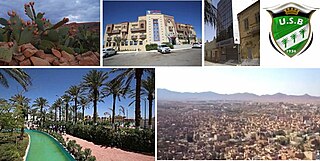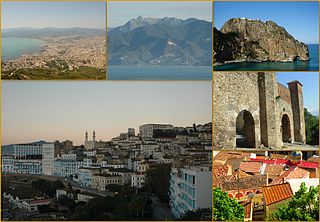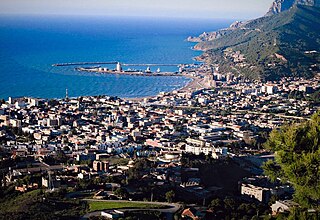
Algeria, officially the People's Democratic Republic of Algeria, is a country in the Maghreb region of North Africa. It is bordered to the northeast by Tunisia; to the east by Libya; to the southeast by Niger; to the southwest by Mali, Mauritania, and Western Sahara; to the west by Morocco; and to the north by the Mediterranean Sea. The capital and largest city is Algiers, located in the far north on the Mediterranean coast.

Oran is a major coastal city located in the northwest of Algeria. It is considered the second most important city of Algeria, after the capital, Algiers, because of its population and commercial, industrial and cultural importance. It is 432 km (268 mi) west-southwest from Algiers. The total population of the city was 803,329 in 2008, while the metropolitan area has a population of approximately 1,500,000, making it the second-largest city in Algeria.

Tlemcen is the second-largest city in northwestern Algeria after Oran and is the capital of Tlemcen Province. The city has developed leather, carpet, and textile industries, which it exports through the port of Rachgoun. It had a population of 140,158, as of the 2008 census.

Arabic, particularly the Algerian Arabic dialect, is the most widely spoken language in Algeria, but a number of regional and foreign languages are also spoken. The official languages of Algeria are Arabic and Berber, as specified in its constitution since 1963 for the former and since 2016 for the latter. Berber has been recognized as a "national language" by constitutional amendment since 8 May 2002. In February 2016, a constitutional resolution was passed making Berber an official language alongside Arabic. Arabic is spoken by about 81% of Algerians, while Berber languages are spoken by 27%. French, though it has no official status, is still used in media and education due to Algeria's colonial history. Kabyle, with 3 million speakers, is the most spoken Berber language in the country, is taught and partially co-official in parts of Kabylie.

Mers El Kébir is a port on the Mediterranean Sea, near Oran in Oran Province, northwest Algeria. It is famous for the attack on the French fleet in 1940, in the Second World War.

Biskra is the capital city of Biskra Province, Algeria. In 2007, its population was recorded as 307,987. Biskra is located in northeastern Algeria, about 248 miles (399 km) from Algiers, 71 miles (114 km) southwest of Batna and 137 miles (220 km) north of Touggourt. It is nicknamed "The Queen of the Zibans", "The Door of the Desert" or "The Saharan Nice" because of its location at the beginning of the Sahara Desert. Due to its geographical location, its climate and natural resources, particularly farming, Biskra has always been a crossroad between the cities in the north and south. It has seen the passage of several civilizations, from the Romans and the Arabs to the French.

Béjaïa formerly Bougie and Bugia, is a Mediterranean port city and commune on the Gulf of Béjaïa in Algeria; it is the capital of Béjaïa Province.

Oran Province is a province (wilayah) in Algeria whose seat is the city of the same name.

The Kabyle people are a Berber ethnic group indigenous to Kabylia in the north of Algeria, spread across the Atlas Mountains, 160 kilometres (100 mi) east of Algiers. They represent the largest Berber population of Algeria and the second largest in North Africa.

Ténès is a town in Algeria located around 200 kilometers west of the capital Algiers. As of 2000, it has a population of 65,000 people.

Chetaïbi is a small fishing port in Annaba Province, Algeria located on a peninsula west of Annaba.

The Berber calendar is the agricultural calendar traditionally used by Berbers. The calendar is utilized to regulate the seasonal agricultural works.

Rusadir was an ancient Punic and Roman town at what is now Melilla, Spain, in northwest Africa. Under the Roman Empire, it was a colony in the province of Mauretania Tingitana.

The French conquest of Algeria took place between 1830 and 1903. In 1827, an argument between Hussein Dey, the ruler of the Regency of Algiers, and the French consul escalated into a blockade, following which the July Monarchy of France invaded and quickly seized Algiers in 1830, and seized other coastal communities. Amid internal political strife in France, decisions were repeatedly taken to retain control of the territory, and additional military forces were brought in over the following years to quell resistance in the interior of the country.

Bethioua, formerly Arsenaria, Portus Magnus, Arzew, Vieil Arzew, and Saint Leu, is a port town and district near Arzew in Oran Province in northwestern Algeria. It has a gas port, petrochemical facilities and desalination plant.

Mers El Hadjadj is a town and commune in mascara Province, Algeria. According to the 1998 census it has a population of 14,167.

The pacification of Algeria, also known as the Algerian genocide, refers to violent military operations between 1830 to 1875 during the French conquest of Algeria, that often involved ethnic cleansing, massacres and forced displacement, aimed at repressing various tribal rebellions by the native Algerian population. Out of an estimated population of 3 million, between 500,000 and 1 million Algerians were killed. During this period, France formally annexed Algeria in 1834, and approximately 1 million European settlers moved to the Algerian colony. Various governments and scholars consider France's actions in Algeria as constituting a genocide.
The following is a timeline of the history of the city of Oran, Algeria.

Roman colonies in North Africa are the cities—populated by Roman citizens—created in North Africa by the Roman Empire, mainly in the period between the reigns of Augustus and Trajan.

Portus Magnus was a Roman port and colony in western Mauretania Caesariensis near Portus Divinus. Its ruins are now under and around Bethioua in Algeria's Oran Province. In the early modern period, Bethioua still housed several notable Roman mosaics and other artwork, most of which have since been removed to the museum at the provincial capital Oran.























